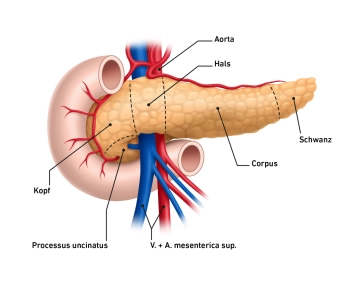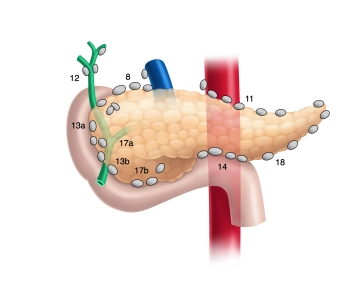- The pancreas, composed of lobules, has a reddish-gray color, is 14 – 18 cm long, and weighs 65 – 80 grams. It is located at the level of the 1st and 2nd lumbar vertebrae and extends wedge-shaped from the epigastric region into the left hypochondriac region.
- The pancreas is enclosed by capsule-like connective or fatty tissue and is divided into four sections: head, neck, body, and tail. While a somewhat firmer connective tissue plate is located in the posterior head area, the gland is otherwise predominantly loosely connected dorsally with the connective tissue. As a retroperitoneal organ, the gland is covered with peritoneum on its anterior surface.
- The widest part of the gland is the head of the pancreas, which, located to the right of the spine, fits into the loop formed by the duodenum. Both the anterior and posterior surfaces of the duodenum can be overlaid by glandular tissue to varying degrees here. The head encompasses with its caudal part (uncinate process) from behind the superior mesenteric vein and artery. The groove located in the uncinate process and the remaining part of the pancreatic head is referred to as the pancreatic notch.
- The part of the pancreas located at the level of the 1st lumbar vertebral body represents the transition area from the head to the body, with a width of about 2 cm, and lies over the superior mesenteric vessels. From a surgical perspective, this section is also referred to as the neck of the pancreas.
- The elongated body of the pancreas runs obliquely upward over the 1st and 2nd lumbar vertebrae, bulges ventrally into the omental bursa, and arches towards the splenic hilum, with the transition into the tail occurring without precise anatomical demarcation. Dorsal to the body, alongside the spine, are the aorta, inferior vena cava, and superior mesenteric artery and vein.
- The tail of the pancreas forms the pointed continuation of the glandular body and extends to or into the splenorenal ligament.
- The pancreas can be arranged in various morphological variants, including oblique, S-shaped, transverse, and L-shaped. A horseshoe shape and an inverted V-shape have also been described. The transitions between the morphological variants are fluid.
-
Relevant macroscopic anatomy
![513_Pankreasanatomie.jpeg]()
-
Spatial relationships to other organs and conduits
![Spatial relationships to other organs and conduits]()
- Developmentally, the organ is in close proximity to the upper abdominal organs and vessels.
- Topographically, the pancreas has multiple relationships with adjacent organs and retroperitoneal pathways:
- ventrally, the omental bursa and the posterior surface of the stomach
- to the right, there is a close relationship between the head and the duodenal C
- to the left, the tail of the pancreas extends to the splenic hilum
- the posterior wall of the pancreas touches at the level of the head the portal vein, the superior mesenteric artery and vein as well as the common bile duct, at the level of the body the splenic artery and vein, the inferior mesenteric vein, the inferior vena cava and the abdominal aorta, at the level of the tail the left kidney
Note: Surgically relevant are the following anatomical details
- The inferior mesenteric vein runs under the lower border of the pancreas.
- There is a close relationship between the spleen and stomach in the area of the short gastric arteries and veins,
-
Pancreatic duct system
The approximately 2 mm thick Ductus pancreaticus (Wirsungianus) traverses the organ in its longitudinal extension near the posterior surface and receives numerous short ductal branches that enter it perpendicularly along its course. In about 77% of cases, the duct joins with the common bile duct at the Papilla duodeni major (Papilla Vateri) in the posterior wall area of the descending part of the duodenum; in the remaining cases, the openings of both ducts are located close to each other. The Ductus pancreaticus accessorius, an accessory duct, is often only rudimentarily developed or completely absent. If present, it opens at the Papilla duodeni minor (Papilla Santorini).
-
Vascular supply
![513_AN_01 Arterien Pankreas.jpg]()
![513_AN_02 Venen Pankreas.jpg]()
- The vascular supply of the pancreas is ensured by numerous vessels.
- Head: The arterial supply of the pancreatic head is provided by the superior pancreaticoduodenal artery, which usually originates from the gastroduodenal artery from the common hepatic artery. Additionally, an anterior superior pancreaticoduodenal artery and a posterior superior pancreaticoduodenal artery are distinguished. These supply the anterior and posterior margins of the duodenum and pancreas through duodenal branches and pancreatic branches, respectively.
- The pancreatic head is also supplied from caudally by the inferior pancreaticoduodenal artery, which comes from the superior mesenteric artery.
- While the blood supply of the head is relatively constant, the body and tail have a variable vascular supply: this is usually provided by variable branches of the splenic artery as well as branches of the transverse pancreatic artery.
- The venous drainage from the pancreatic head occurs via the superior mesenteric vein, while the body and tail belong to the drainage area of the splenic vein. Both drain into the portal vein.
Note: The branches of the superior and inferior pancreaticoduodenal arteries form the so-called Rio Blanco arcade, which represents a vascular anastomosis between the supply areas of the celiac trunk and the superior mesenteric artery.
-
Lymphatic vessels and nodes
![513_AN_03 Lks Zahlen groß.jpg]()
- The lymphatic vessels of the pancreas run parallel to the blood vessels to all locoregional lymph nodes.
- Lymph node station 1: The peripancreatic lymph nodes (1st station) are closely attached to the gland, partially even located superficially in the glandular parenchyma. At the upper edge of the organ, there is a chain of lymph nodes extending from the splenic hilum to the hepatoduodenal ligament, with additional lymph nodes located ventrally and dorsally between the pancreatic head and duodenum, at the lower edge of the pancreas, and in the caudal area.
- Lymph node station 2: The other relevant lymph nodes (2nd station) are located near the celiac trunk, the superior mesenteric artery and vein, as well as on both sides of the aorta.
-
Function
- The pancreas is a gland and includes both an exocrine and an endocrine glandular part.
- The exocrine glandular portion constitutes the main part of the pancreas with 98% of the volume. It represents the most important digestive gland of humans. Numerous digestive enzymes and proenzymes are formed here and secreted by it. Up to 1.5 liters of pancreatic secretion are produced per day.
- The exocrine secretion consists of:
- Proteases for protein digestion
- Alpha-amylase for carbohydrate digestion
- Nucleases for nucleic acid digestion
- Lipases for fat digestion
- In addition, bicarbonate is produced in the pancreas, which is needed in the duodenum to neutralize stomach acid.
- The secretion of the exocrine portion is delivered to the duodenum via the duct system.
- The exocrine secretion consists of:
- The endocrine portion is significantly smaller in volume, making up only 2%. It consists of 1-2 million small cell clusters (islets of Langerhans), which are irregularly embedded in the exocrine glandular tissue, primarily in the tail of the pancreas. Their entirety is referred to as the "islet organ."
- The islet organ produces the following hormones, which are released directly into the blood:
- Glucagon (alpha cells)
- Insulin (beta cells)
- Somatostatin (delta cells)
- Pancreatic polypeptide
- Ghrelin
- Serotonin
- The islet organ produces the following hormones, which are released directly into the blood:





